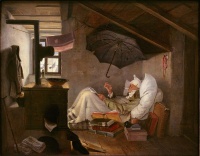Tortured artist
From The Art and Popular Culture Encyclopedia

Van Gogh struggled with poverty and mental illness for most of his life is regarded as a famous example of the tortured artist.
|
Related e |
|
Featured: |
The tortured artist is a stock character and real-life stereotype who is in constant torment due to frustrations with art and other people. Tortured artists feel alienated and misunderstood due to the perceived ignorance or neglect of others who do not understand nor support them and the things they feel are important. They sometimes smoke, experience sexual frustration and recurring heartbreak, and generally appear overwhelmed by their own emotions and inner conflicts. They are often mocked in popular culture for "thinking too much", being quixotic, or coming across as pretentiously adverse to happiness and fun. Other stereotypical traits vary between extremes – from being narcissistic and extroverted to being self-loathing and introverted. Tortured artists are often self-destructive in behavior and are generally associated with mental health issues such as substance abuse, personality disorders, or depression. Tortured artists are often prone to self-mutilation and have a high rate of suicide.
Typical real-life artists include Jackson Pollock, Egon Schiele and Vincent van Gogh.
In books
The 1996 book Touched with Fire, by American psychologist Kay Redfield Jamison, looks at the relationship between bipolar disorder and artistic creativity. It contains a number of case histories of dead people who are described as probably having suffered from bipolar disorder.
The 2012 book Tortured Artists, by the American journalist Christopher Zara, shows the universal nature of the tortured artist stereotype and how it applies to all of the creative disciplines, including film, theater, literature, music, and visual art. The artists profiled in the book have generally made major contributions to their respective mediums (Charles M. Schulz, Charlie Parker, Lenny Bruce, Michelangelo, Madonna, Andy Warhol, Amy Winehouse, and dozens of others), but the book shows how, in each case, their art was inspired by pain and suffering.
Examples
- Pete Doherty
- Dante Alighieri
- Kurt Cobain
- Marilyn Monroe
- Ian Curtis
- Nick Drake
- F. Scott Fitzgerald
- Judy Garland
- Vincent Van Gogh
- Ernest Hemingway
- Daniel Johnston
- Franz Kafka
- Frida Kahlo
- John Lennon
- H. P. Lovecraft
- Sylvia Plath
- Edgar Allan Poe
- Robert Schumann
- Elliott Smith
- Pyotr Ilyich Tchaikovsky
- Hunter S. Thompson
- John Kennedy Toole
- Oscar Wilde
- Syd Barrett
- Virginia Woolf
See also
- Artist
- Beautiful loser
- Bohemianism
- Bohemianism and 'artistism'
- Byronic hero
- Creativity and mental illness
- Fou littéraire
- Mad genius
- Mental disorders in art
- Outsider art
- Pathologizing the artist
- Paintings by Adolf Hitler
- Poète maudit
- Starving artist
- Self-destructive behaviour
- Tortured
- Unpopularity
- Self Portrait with Bandaged Ear by Vincent van Gogh



